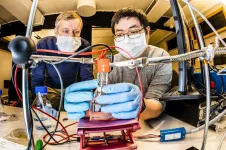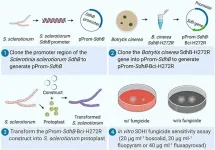INFORMATION:
No funding was received to perform this work.
CITATION: "A Metabolomics Comparison of Plant-Based Meat and Grass-fed Meat Indicates Large Nutritional Differences Despite Comparable Nutrition Facts Panels," Stephan van Vliet, James Bain, Michael Muehlbauer, Frederick Provenza, Scott Kronberg, Carl Pieper, Kim Huffman. Scientific Reports, July 5, 2021. DOI: 10.1038/s41598-021-93100-3
Online: https://rdcu.be/cnKRJ
Lab analysis finds near-meat and meat not nutritionally equivalent
Neither is good or bad, they are just not the same, authors say
2021-07-06
(Press-News.org) DURHAM, N.C. -- Plant-based meat substitutes taste and chew remarkably similar to real beef, and the 13 items listed on their nutrition labels - vitamins, fats and protein -- make them seem essentially equivalent.
But a Duke University research team's deeper examination of the nutritional content of plant-based meat alternatives, using a sophisticated tool of the science known as 'metabolomics,' shows they're as different as plants and animals.
Meat-substitute manufacturers have gone to great lengths to make the plant-based product as meaty as possible, including adding leghemoglobin, an iron-carrying molecule from soy, and red beet, berries and carrot extracts to simulate bloodiness. The texture of near-meat is thickened by adding indigestible fibers like methyl cellulose. And to bring the plant-based meat alternatives up to the protein levels of meat, they use isolated plant proteins from soy, peas, and other plant sources. Some meat-substitutes also add vitamin B12 and zinc to further replicate meat's nutrition.
However, many other components of nutrition do not appear on the labels, and that's where the products differ widely from meat, according to the study, which appears this week in Scientific Reports.
The metabolites that the scientists measured are building blocks of the body's biochemistry, crucial to the conversion of energy, signaling between cells, building structures and tearing them down, and a host of other functions. There are expected to be more than 100,000 of these molecules in biology and about half of the metabolites circulating in human blood are estimated to be derived from our diets.
"To consumers reading nutritional labels, they may appear nutritionally interchangeable," said Stephan van Vliet, a postdoctoral researcher at the Duke Molecular Physiology Institute who led the research. "But if you peek behind the curtain using metabolomics and look at expanded nutritional profiles, we found that there are large differences between meat and a plant-based meat alternative."
The Duke Molecular Physiology Institute's metabolomics core lab compared 18 samples of a popular plant-based meat alternative to 18 grass-fed ground beef samples from a ranch in Idaho. The analysis of 36 carefully cooked patties found that 171 out of the 190 metabolites they measured varied between beef and the plant-based meat substitute.
The beef contained 22 metabolites that the plant substitute did not. The plant-based substitute contained 31 metabolites that meat did not. The greatest distinctions occurred in amino acids, dipeptides, vitamins, phenols, and types of saturated and unsaturated fatty acids found in these products.
Several metabolites known to be important to human health were found either exclusively or in greater quantities in beef, including creatine, spermine, anserine, cysteamine, glucosamine, squalene, and the omega-3 fatty acid DHA. "These nutrients have potentially important physiological, anti-inflammatory, and or immunomodulatory roles," the authors said in the paper.
"These nutrients are important for our brain and other organs including our muscles" van Vliet said. "But some people on vegan diets (no animal products), can live healthy lives - that's very clear." Besides, the plant-based meat alternative contained several beneficial metabolites not found in beef such as phytosterols and phenols.
"It is important for consumers to understand that these products should not be viewed as nutritionally interchangeable, but that's not to say that one is better than the other," said van Vliet, a self-described omnivore who enjoys a plant-heavy diet but also eats meat. "Plant and animal foods can be complementary, because they provide different nutrients."
He said more research is needed to determine whether there are short-term or long-term effects of the presence or absence of particular metabolites in meat and plant-based meat alternatives.
ELSE PRESS RELEASES FROM THIS DATE:
New study pinpoints two separate mutation near GDF5 gene for osteoarthritis, hip dysplasia
2021-07-06
Terence D. Capellini has been interested in how joints work for almost three decades. Part of it is due to personal experience, having sustained several joint injuries as a college ice hockey player and recently developing knee osteoarthritis. But the principal investigator of Harvard's Developmental and Evolutionary Genetics Lab has also seen the pain and limited mobility of loved ones who've received similar diagnoses and injuries.
"We have all these joints in the body and they don't look the same from one another," said Capellini, the Richard B. Wolf Associate Professor in the Department of Human Evolutionary ...
Melanoma registry results shine light on rare pediatric cancer
2021-07-06
Pediatric melanoma is a rare disease with only around 400 cases diagnosed in the United States every year. To better understand this disease and how best to treat it, St. Jude Children's Research Hospital scientists created a registry called Molecular Analysis of Childhood MELanocytic Tumors (MACMEL). A paper on findings from the registry was published today in Cancer.
"What is different about the MACMEL registry is that it is prospective," said corresponding author Alberto Pappo, M.D., St. Jude Solid Tumor Division director. "We're seeing the vast majority of enrolled patients as part of the melanoma clinic at St. Jude. We can follow these patients and conduct detailed pathology and molecular analysis."
More ...
Colorectal cancer risk may increase with lower exposure to UVB light
2021-07-06
University of California San Diego School of Medicine researchers have identified a possible link between inadequate exposure to ultraviolet-B (UVB) light from the sun and an increased risk of colorectal cancer, especially as people age.
Reporting in the journal BMC Public Health, researchers investigated global associations between levels of UVB light -- one of several types of ultraviolet light that reach the Earth's surface -- in 2017 and rates of colorectal cancer across several age groups in 186 countries in 2018.
Lower UVB exposure was significantly correlated with higher rates of colorectal ...
Story tips: Powered by nature, get on the bus, accelerating methane and more
2021-07-06
Manufacturing - Powered by nature
A team of researchers at Oak Ridge National Laboratory demonstrated the ability to additively manufacture power poles from bioderived and recycled materials, which could more quickly restore electricity after natural disasters.
Using the Big Area Additive Manufacturing system, the team 3D printed a 55-foot pole designed as a closed cylindrical structure. They evaluated three different composite materials with glass fibers including cellulose ester, recycled polycarbonate and bamboo fiber reinforced polystyrene.
"We developed a modular design that is easy to manufacture, transport and assemble," ORNL's Halil Tekinalp said. "Sections within the pole can ...
Biochemical pathway to skin darkening holds implications for prevention of skin cancers
2021-07-06
BOSTON - A skin pigmentation mechanism that can darken the color of human skin as a natural defense against ultraviolet (UV)-associated cancers has been discovered by scientists at Massachusetts General Hospital (MGH). Mediating the biological process is an enzyme, NNT, which plays a key role in the production of melanin (a pigment that protects the skin from harmful UV rays) and whose inhibition through a topical drug or ointment could potentially reduce the risk of skin cancers. The study was published online in Cell.
"Skin pigmentation and its regulation are critically important because pigments confer major protection against UV-related cancers ...
Fecal transplant plus fibre improves insulin sensitivity in severely obese
2021-07-06
A transplant of healthy gut microbes followed by fibre supplements benefits patients with severe obesity and metabolic syndrome, according to University of Alberta clinical trial findings published today in Nature Medicine.
Patients who were given a single-dose oral fecal microbial transplant followed by a daily fibre supplement were found to have better insulin sensitivity and higher levels of beneficial microbes in their gut at the end of the six-week trial. Improved insulin sensitivity allows the body to use glucose more effectively, reducing blood sugar.
"They were much more metabolically healthy," said principal investigator Karen Madsen, professor of medicine in the Faculty of Medicine ...
A new look at color displays
2021-07-06
Researchers at Linköping University have developed a method that may lead to new types of displays based on structural colours. The discovery opens the way to cheap and energy-efficient colour displays and electronic labels. The study has been published in the scientific journal Advanced Materials.
We usually think of colours as created by pigments, which absorb light at certain wavelengths such that we perceive colour from other wavelengths that are scattered and reach our eyes. That's why leaves, for example, are green and tomatoes red. But colours can be created ...
New broadly applicable tool provides insight into fungicide resistance
2021-07-06
Succinate dehydrogenase inhibitors (SDHIs) are a class of fungicides widely used to control many fungal diseases of crops. The relationship between SDHIs and fungi can be compared to finding the right key for the right lock. However, fungi are adaptable and develop resistance to fungicides often by changing the lock so that the SDHI is no longer able to open the door. Because of this adaptability, it is important to understand the biological mechanisms of fungicide resistance.
A recent collaboration between scientists in Michigan and Massachusetts as ...
Bacterial survival kit to endure in soil
2021-07-06
However, the majority of these organisms are believed to be in a state a state of 'dormancy' due to environmental stress, such as nutrient-poor conditions. An international team of scientists led by Dagmar Woebken and Stephanie A. Eichorst from the University of Vienna investigated how acidobacteria, which are widespread in soils, can survive under adverse conditions. Two recent studies published in The ISME Journal and mSystems describe these survival strategies.
The living conditions that microorganisms encounter in soils are unpredictable and challenging. Nutrients and oxygen are frequently scarce for long periods. Acidobacteria manage to defy these extreme conditions. They are found in an astonishing diversity in soils worldwide. "Since they are this widespread, ...
How an unfolding protein can induce programmed cell death
2021-07-06
The death of cells is well regulated. If it occurs too much, it can cause degenerative diseases. Too little, and cells can become tumours. Mitochondria, the power plants of cells, play a role in this programmed cell death. Scientists from the University of Groningen (the Netherlands) and the University of Pittsburgh (U.S.) have obtained new insights in how mitochondria receive the signal to self-destruct. Their results were published in the Journal of Molecular Biology.
How does a cell kill itself? The details of this process are still unclear. Patrick van der Wel, associate professor ...
LAST 30 PRESS RELEASES:
Tracing the quick synthesis of an industrially important catalyst
New software sheds light on cancer’s hidden genetic networks
UT Health San Antonio awarded $3 million in CPRIT grants to bolster cancer research and prevention efforts in South Texas
Third symposium spotlights global challenge of new contaminants in China’s fight against pollution
From straw to soil harmony: International team reveals how biochar supercharges carbon-smart farming
Myeloma: How AI is redrawing the map of cancer care
Manhattan E. Charurat, Ph.D., MHS invested as the Homer and Martha Gudelsky Distinguished Professor in Medicine at the University of Maryland School of Medicine
Insilico Medicine’s Pharma.AI Q4 Winter Launch Recap: Revolutionizing drug discovery with cutting-edge AI innovations, accelerating the path to pharmaceutical superintelligence
Nanoplastics have diet-dependent impacts on digestive system health
Brain neuron death occurs throughout life and increases with age, a natural human protein drug may halt neuron death in Alzheimer’s disease
SPIE and CLP announce the recipients of the 2025 Advanced Photonics Young Innovator Award
Lessons from the Caldor Fire’s Christmas Valley ‘Miracle’
Ant societies rose by trading individual protection for collective power
Research reveals how ancient viral DNA shapes early embryonic development
A molecular gatekeeper that controls protein synthesis
New ‘cloaking device’ concept to shield sensitive tech from magnetic fields
Researchers show impact of mountain building and climate change on alpine biodiversity
Study models the transition from Neanderthals to modern humans in Europe
University of Phoenix College of Doctoral Studies releases white paper on AI-driven skilling to reduce burnout and restore worker autonomy
AIs fail at the game of visual “telephone”
The levers for a sustainable food system
Potential changes in US homelessness by ending federal support for housing first programs
Vulnerability of large language models to prompt injection when providing medical advice
Researchers develop new system for high-energy-density, long-life, multi-electron transfer bromine-based flow batteries
Ending federal support for housing first programs could increase U.S. homelessness by 5% in one year, new JAMA study finds
New research uncovers molecular ‘safety switch’ shielding cancers from immune attack
Bacteria resisting viral infection can still sink carbon to ocean floor
Younger biological age may increase depression risk in older women during COVID-19
Bharat Innovates 2026 National Basecamp Showcases India’s Most Promising Deep-Tech Ventures
Here’s what determines whether your income level rises or falls
[Press-News.org] Lab analysis finds near-meat and meat not nutritionally equivalentNeither is good or bad, they are just not the same, authors say




